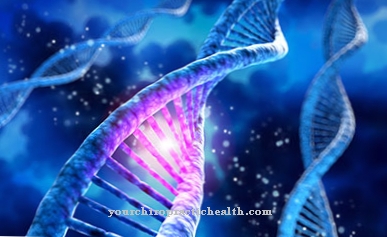At the α-N-acetylgalactosaminidase deficiency it is a lysosomal storage disease that occurs very rarely. It is divided into a juvenile and an adult form.
What is a-N-Acetylgalactosaminidase Deficiency?

The a-N-acetylgalactosaminidase deficiency or Alpha-N-acetylgalactosaminidase deficiency is also called in medicine Schindler's disease, Schindler's disease or Kanzaki's disease designated. What is meant is an extremely rare lysosomal storage disease, the inheritance of which is autosomal recessive. Doctors differentiate between a juvenile form, which occurs in children and adolescents, and an adult form, from which adults suffer.
The juvenile form of alpha-N-acetylgalactosaminidase deficiency is called Schindler's disease, while the adult form is called Kanzaki's disease. But there are also subdivisions into Schindler's disease type I for the youthful form and Schindler's disease type II for the adult form. A mixture of both forms, known as Schindler's disease type III, is also possible.
All three forms of the disease are oligosaccharidoses (glycoproteinoses), which include fucosidosis and sialic acid storage disease. The name Schindler's disease or Schindler's disease for the alpha-N-acetylgalactosaminidase deficiency goes back to the German geneticist Detlev Schindler.
He was the first to describe the disease in 1988. A year later, the Japanese physician T. Kanzaki described the adult form. He discovered in 1991 that an alpha-N-acetylgalactosaminidase deficiency was the cause of the disease.
causes
The α-N-acetylgalactosaminidase deficiency is caused by a reduced activity of the enzyme alpha-N-acetylgalactosaminidase. Missense or nonsense mutations on the NAGA gene, which codes for alpha-N-acetylgalactosaminidase, are responsible for the enzyme defect.
The NAGA gene is located on chromosome 22 gene locus q11. The enzyme alpha-N-acetylgalactosaminidase has the task of catalyzing the cleavage of N-acetylgalactosamine from various glycolipids and glycoproteins. The genetic defect causes a reduced activity of the enzyme, so that substances that are not metabolized accumulate in the body cells.
In most cases these are proteoglycans, glycosphingolipids and N- or O-linked glycoproteins. The accumulation of these causes damage to the cell and the affected organs. Alpha-N-acetylgalactosaminidase deficiency is so rare that there is no precise information about its frequency.
So far, only twelve patients from eight families are known to have developed Schindler's disease in the world. Neurological complaints do not occur in every patient. Some physicians suspect the influence of additional factors for the occurrence of neurological symptoms. However, there is still no evidence to support this assumption.
You can find your medication here
➔ Medicines for painSymptoms, ailments & signs
The symptoms of alpha-N-acetylgalactosaminidase deficiency depend on the particular form of the disease. In the context of Schindler's disease type I, progressive muscle hypotonia occurs in the first year of life. In addition, the affected babies suffer from pronounced psychomotor regression.
Disturbances of the movement sequence, spastic tetraplegia and myoclonic cerebral seizures were also recorded as symptoms. There is also a risk of the child becoming blind. If there is an adult form of alpha-N-acetylgalactosaminidase deficiency, i.e. Schindler's disease type 2, symptoms similar to Fabry's disease occur.
Patients have angiokeratomas, which are benign skin changes. Many patients are slightly mentally retarded. A clinical intermediate form is Schindler's disease type III. Those affected suffer from neurological malfunctions, cerebral seizures and mental disabilities.
Less severe forms are also possible, however, which are associated with mild psychiatric and neurological complaints, delayed language development or symptoms similar to autism.
Diagnosis & course
The diagnosis of an alpha-N-acetylgalactosaminidase deficiency is possible through the detection of a reduced NAGA activity. For this purpose, enzyme tests are carried out in blood plasma, leukocytes or cultured fibroblasts or lymphoblasts. The chromatographic detection of oligosaccharides in the urine also enables the diagnosis of enzyme deficiency.
A DNA analysis can also be carried out, but this is not necessary in most cases. During pregnancy, prenatal diagnosis of enzyme deficiency can also be carried out using a mutation analysis of the NAGA gene following a chorionic villus sampling or amniocentesis. However, the respective form of the disease cannot be determined.
The differential diagnosis of Fabry syndrome, panthothenate kinase-associated neurodegeneration and infantile neuroaxonal dystrophy, which also have enzyme defects, is also important. The course of the alpha-N-acetylgalactosaminidase deficiency depends on the respective form of the disease.
Schindler's disease type I is considered unfavorable, while the prognosis for the other two types is more favorable. However, the number of sick people is so small that no meaningful statements can be made about life expectancy.
Complications
The symptoms and complications of A-N-acetylgalactosaminidase deficiency depend heavily on its form.In most cases, however, movement disorders occur, so that those affected are relatively restricted in their everyday lives. Cramps also occur, which are associated with severe pain.
Babies in particular suffer from severe developmental disorders, which can lead to spasticity in the child. In some cases, the A-N-acetylgalactosaminidase deficiency leads to complete blindness in the patient. The regression of intelligence leads to retardation and thus to disabilities.
These usually restrict the patient's everyday life considerably and have a negative effect on the quality of life. Often those affected are dependent on the help of other people. The retardation can also lead to a word finding disorder or a language disorder. It is not possible to treat the A-N-acetylgalactosaminidase deficiency causally.
For this reason, the affected person must take antibiotics. Certain complications must also be avoided directly. Pneumonia, for example, is one of these. Furthermore, the patient can also be dependent on artificial nutrition.
When should you go to the doctor?
A-N-acetylgalactosaminidase deficiency must definitely be treated by a doctor. This deficiency does not go away by itself and there is no spontaneous healing of this disease. In any case, a doctor must be consulted if the parents notice a decline in motor and mental abilities in their child or baby. Complaints with simple movements or processes can also indicate the A-N-acetylgalactosaminidase deficiency and should be examined by a doctor.
Furthermore, various spasticity are also a sign of an illness. It is not uncommon for patients to suffer from intellectual disabilities and other malfunctions. If these complaints are present, treatment is definitely necessary. If there is no treatment, this can lead to considerable complaints and complications in adulthood and thus considerably reduce the quality of life of the person affected.
Severely delayed speech development can also be a sign of A-N-acetylgalactosaminidase deficiency and must therefore be investigated. As a rule, a general practitioner can be consulted to determine the A-N-acetylgalactosaminidase deficiency. The further treatment of the individual complaints is then carried out by a specialist.
Doctors & therapists in your area
Treatment & Therapy
A causal therapy for alpha-N-acetylgalactosaminidase deficiency is not feasible. Therefore, the medical approach is limited to treating the symptoms. This includes a sensible diet and fluid intake, the prevention of infectious diseases, which can also be done by administering antibiotics, and the containment of cerebral attacks by administering anti-epileptic drugs.
Further treatment steps include physiotherapy measures to prevent pneumonia and contractures, and to reduce pain or spasticity with the help of medication. Furthermore, aspiration prophylaxis can take place through artificial feeding.
Recent studies have shown that a-N-acetylgalactosaminidase deficiency is a protein folding disorder, so that enzyme replacement therapy is being discussed as a sensible treatment measure. Gene therapy is another conceivable therapeutic approach for the treatment of lysosomal storage disorders. Because Schindler's disease is inherited in an autosomal recessive manner, genetic counseling of the affected families is recommended.
Outlook & forecast
The A-N-acetylgalactosaminidase deficiency can lead to different symptoms. In most cases, however, the deficiency leads to delayed psychomotor development. In adulthood, the patient is often dependent on the help of other people and cannot cope with everyday life on his own. Movement disorders also occur. This can be noticed by a limp or by disturbances of the coordination.
In the worst case, the patient can go blind or suffer from severe visual disturbances due to the A-N-acetylgalactosaminidase deficiency. It is not uncommon for intellectual disabilities to occur that greatly reduce the quality of life of the person concerned. Speech disorders and word finding disorders also occur, which can affect life. Children in particular are affected by bullying and teasing due to the symptoms of A-N-acetylgalactosaminidase deficiency.
A causal treatment of the A-N-acetylgalactosaminidase deficiency is not possible, so that the treatment is primarily aimed at reducing the symptoms. Various therapeutic measures can be used to reduce developmental disorders. In many cases, however, the patient is dependent on outside help in everyday life. Life expectancy is not affected by the deficiency.
You can find your medication here
➔ Medicines for painprevention
There are no known preventive measures against alpha-N-acetylgalactosaminidase deficiency. Schindler's disease is one of the extremely rare diseases.
Aftercare
Since A-N-acetylgalactosaminidase deficiency is a congenital disease that cannot be treated causally but only symptomatically, a complete treatment is not possible. The affected person is dependent on lifelong treatment, which is why the options for aftercare are very limited.
As a rule, due to the A-N-acetylgalactosaminidase deficiency, the patient is often dependent on the intake of medication and antibiotics. Possible interactions with other medications should be taken into account, although antibiotics should not be taken together with alcohol. If you have an attack, you should go to the hospital or call an emergency doctor directly.
Furthermore, the lungs should be spared to avoid inflammation. Therefore, patients with A-N-acetylgalactosaminidase deficiency should not smoke under any circumstances. A healthy diet and a generally healthy lifestyle have a very positive effect on the course of the disease.
If the patient wishes to have children, genetic counseling is useful in order to prevent the disease from being passed on to the children. Since the patients often suffer from restricted mobility, physiotherapy is useful to alleviate this. Many exercises can also be performed in your own home.
You can do that yourself
An existing A-N-acetylgalactosaminidase deficiency is an incurable disease. Medical treatment is therefore essential. Self-treatment measures can only be based on the symptoms to make everyday life easier. It is important that the parents observe the child closely.
Parents can best help their child through understanding and patience, love and care. Furthermore, occupational therapy and speech therapy treatments are always based on a dual concept: on-site therapy with the specialist and performing the exercises at home. Parents should be active here consistently and with patience. A diet rich in vitamins and minerals, regular exercise and plenty of fresh air must be ensured. This strengthens the immune system and reduces the risk of infection. If the person has a tendency to seize, they should not be alone for a long time and they should be checked to see whether they can injure themselves if a seizure occurs.
Most of the time, patients cannot cope with everyday life themselves and require constant care. If parents cannot afford this - especially with older children and adults - they should not be afraid to seek help. This can take the form of a nurse or placement in an adequate facility. If you still want to have children, a consultation with a specialist is recommended, as the disease is inherited.



.jpg)








.jpg)



.jpg)










.jpg)
